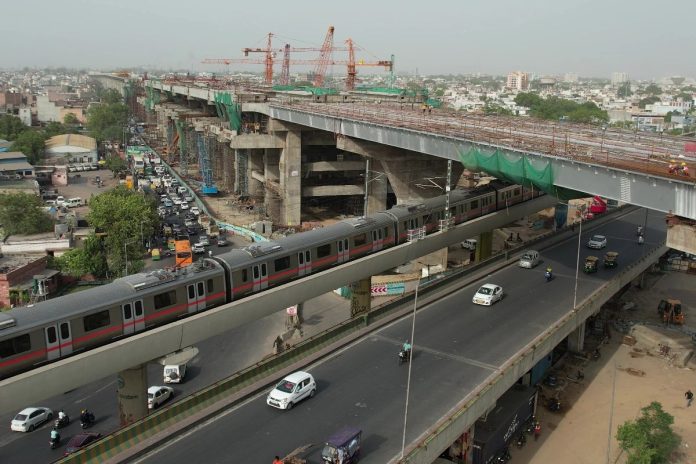Snapshot
The steel span is 150 meters long and weighs about 3200 tonnes.
It is part of a 17 km long priority section from Sahibabad to Duhai, which is targeted to be operational by the year 2023.
NCRTC has successfully installed the longest steel span (bridge) of the Delhi-Ghaziabad-Meerut RRTS corridor to cross the metro line and roadway bridge near Ghaziabad station.
The steel span or bridge is 150 meters long and weighs about 3200 tonnes. This span is installed on three pillars of 25 meters in height. The steel span is part of a 17 km long priority section from Sahibabad to Duhai, which is targeted to be operational by the year 2023.
With the successful installation of this steel span, another phase of the construction of India’s first RRTS corridor between Delhi and Meerut has been completed. Eight girders were placed parallelly to build this steel span and the track laying work will commence soon.
Through the span, NCRTC has connected the viaduct coming from the Sahibabad side with the platform of Ghaziabad station. With the completion of this span, the viaduct between Sahibabad station and Ghaziabad station is now complete.
So far, NCRTC has installed five such steel spans, one at a railway crossing in Ghaziabad, one over the metro viaduct near Ghaziabad RRTS station, and three on the Eastern Peripheral to commute to Duhai and Meerut.
NCRTC has established this steel span with all safety measures in cooperation with Metro Line and Road Bridge-related departments. Since it is a very heavy steel structure, this massive steel span is set up by tandem lifting with a crane. This task was very challenging and complex and has been completed successfully.
NCRTC usually erects pillars at an average distance of 34 meters for the construction of an elevated viaduct of the RRTS corridor. These pillars are joined by precast segments with the help of a launching gantry to form the RRTS viaduct span.
However, in some complex areas where the corridor crosses rivers, bridges, rail crossings, metro corridors, expressways or other such existing infrastructure, it is practically not possible to maintain this distance between pillars. In such areas, steel spans are being used to connect the pillars. Segments of structural steel are first manufactured in the factory and then brought to the site, after which these segments are assembled into steel spans.
These segments are brought to the site by trailers during the night to avoid any traffic problems. More than 14,000 workers and over 1100 engineers are working day and night on the 82 km long RRTS corridor.
With the construction of the viaduct in the priority section, the construction work of all the five stations, Sahibabad, Ghaziabad, Guldhar, Duhai and Duhai depots is going on at a pace. The work of connecting rail tracks on the viaduct between Ghaziabad and Duhai is also going on.
NCRTC has maintained the pace of construction by taking comprehensive pollution control measures in and around construction sites. A dedicated team of experts is regularly monitoring the effectiveness of these measures and intensifying activities wherever necessary.
The construction work is being done in the barricading zones of sufficient height and thorough cleanliness is being taken care of at these sites. Anti-smog guns and water sprinklers have been installed for the disposal of construction dust. All the raw materials and debris are kept covered at their marked sites.


